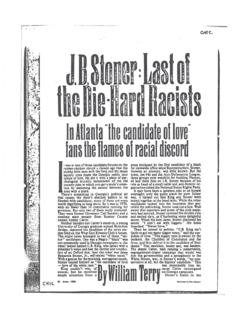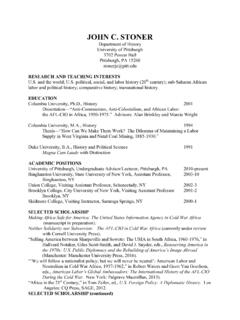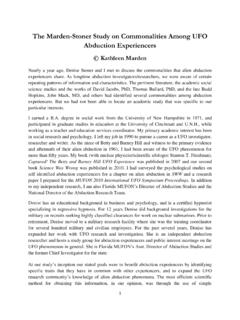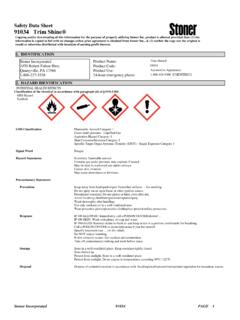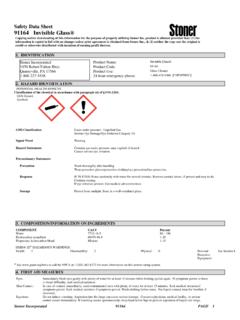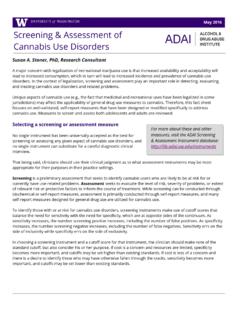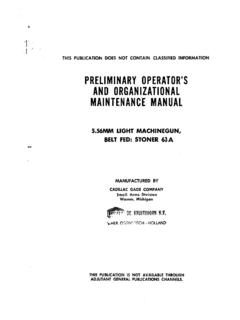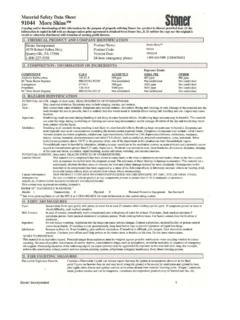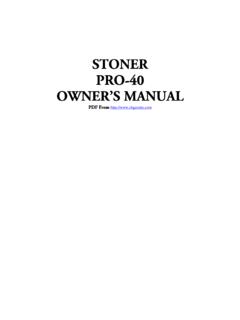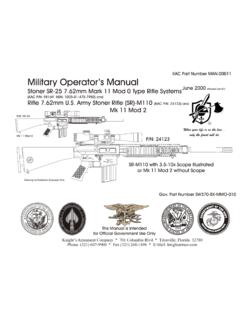Transcription of Material Safety Data Sheet A163 Plastic Surface Cleaner
1 Stoner Incorporated A163 PAGE 1 Material Safety data Sheet A163 Plastic Surface Cleaner Copying and/or downloading of this information for the purpose of properly utilizing Stoner Inc. product is allowed provided that: (1) the information is copied in full with no changes unless prior agreement is obtained from Stoner Inc., & (2) neither the copy nor the original is resold or otherwise distributed with intention of earning profit thereon. 1. CHEMICAL PRODUCT AND COMPANY IDENTIFICATION Stoner Incorporated Product Name: Plastic Surface Cleaner 1070 Robert Fulton Hwy.
2 Product Code: A163 Quarryville, PA 17566 Version Date: 05/18/11 1-800-227-5538 24-hour emergency phone: 1-800-424-9300 [CHEMTREC] 2. COMPOSITION / INFORMATION ON INGREDIENTS Exposure Limits COMPONENT CAS # ACGIH TLV OSHA PEL OTHER Water 7732-18-5 Not established Not established Not established Hydrocarbon propellant 68-476-86-8 800 ppm Not established Not established NJ Trade Secret Registry #80100382-5094P 400 ppm 400 ppm Not established Glycol ether 111-76-2 20 ppm [skin] 50 ppm [skin] Not established Dimethyl carbinol 67-63-0 400 ppm 400 ppm 500 ppm STEL 3. HAZARDS IDENTIFICATION POTENTIAL ACUTE [single or short term] HEALTH EFFECTS OF OVEREXPOSURE Eye : May cause frostbite and irritation.
3 May cause eye irritation. Symptoms may include stinging, tearing, and redness. Skin : Liquid may cause frostbite. Skin contact may cause irritation. Symptoms may include redness, discomfort, drying and cracking, or rash. Ingestion : Irritating to mouth, throat, and stomach. Can cause abdominal discomfort, nausea, vomiting and diarrhea. Inhalation : May cause nausea, vomiting, coughing and pulmonary irritation. Can cause minor respiratory irritation, dizziness, weakness, fatigue, nausea, and headache. Breathing large amounts may be harmful. Symptoms are more typically seen at air concentrations exceeding the recommended exposure limits.
4 Symptoms of exposure may include: initial Central Nervous System excitation (euphoria, exhilaration, light-headedness) followed by CNS depression (dizziness, drowsiness, weakness, fatigue, nausea, headache, unconsciousness) and other CNS effects, such as confusion, impaired coordination, coma, and death. Breathing small amounts during handling is not likely to cause harmful effects. POTENTIAL CHRONIC [long term] HEALTH EFFECTS OF OVEREXPOSURE: General Effects: Upon prolonged or repeated use, can be associated with central nervous system damage. This Material (or a component) has been shown to cause harm to the fetus in laboratory animal studies.
5 Harm to the fetus occurs only at exposure levels that harm the pregnant animal. The relevance of these findings to humans is uncertain. Acute lethal exposures in animal studies of a product component has resulted in congestion of organs including kidney, spleen and lungs. mild, reversible kidney effects. mild, reversible liver effects. blood abnormalities. Overexposure to this Material (or its components) has been suggested as a cause of the following effects in laboratory animals: Cancer Information: THIS PRODUCT CONTAINS NO COMPONENTS LISTED AS CARCINOGENIC BY IARC, NTP, OR OSHA 1910(Z) Mutagenicity: No data available to indicate product or any components present at greater than is mutagenic or genotoxic.
6 MEDICAL CONDITIONS AGGRAVATED BY OVEREXPOSURE: Respiratory related chronic illnesses ( asthma, etc.). Skin contact may aggravate an existing dermatitis. HMIS III* HAZARDOUS WARNINGS: Health: 2 Flammability: 2 Physical: 0 Personal Protective Equipment: See Section 8 * See or call the NPCA at 1 (202) 462-6272 for more information on this current rating system. 4. FIRST AID MEASURES Eyes: Immediately flush eyes gently with plenty of water for at least 15 minutes while holding eyelids apart. If symptoms persist or there is visual difficulty, seek medical attention. Skin Contact: In case of contact, immediately wash contaminated area with plenty of water for at least 15 minutes.
7 Seek medical attention if symptoms persist. Seek medical attention if symptoms persist. Wash clothing before reuse. For liquid contact, treat for frostbite if necessary. Ingestion: Do not induce vomiting. Aspiration into the lungs can cause serious damage. Contact a physician, medical facility, or poison control center immediately. If vomiting occurs spontaneously, keep head below hips to prevent aspiration of liquid into lungs. Inhalation: Remove to fresh air. If not breathing, give artificial respiration. If breathing is difficult, give oxygen. Keep the victim warm and quiet. Seek immediate medical attention. NOTES TO PHYSICIAN: This Material is an aspiration hazard.
8 Potential danger from aspiration must be weighed against possible oral toxicity when deciding whether to induce vomiting. Preexisting disorders of the following organs (or organ systems) may be aggravated by exposure to this Material : lung (for example, asthma-like conditions); liver; kidney; skin; 5. FIRE FIGHTING MEASURES Fire and/or Explosion Hazards: Product is water based Material , containing minor amounts of flammable ingredients. This product contains a component(s) that is considered an extremely flammable gas(es), which has vapors that are heavier than air and may travel along the ground or be moved by ventilation and ignited by heat, pilot lights, or other flames and ignition sources at locations distant from the Material 's handling point.
9 Fire Fighting Instructions: Use CO2, foam or dry chemical. Water is generally not effective and may spread fire; however, water spray may be used from a safe distance to cool closed containers and protect surrounding area. Aerosol Flame Projection Test: Non-flammable aerosol, as determined by ASTM D3065-94. However, this product contains components which may be ignited under certain circumstances. Do not use near ignition sources such as sparks or open flames. Stoner Incorporated A163 PAGE 2 6.
10 ACCIDENTAL RELEASE MEASURES STEPS TO BE TAKEN IF Material IS RELEASED OR SPILLED: Remove all sources of ignition. Wear appropriate personal protective equipment (PPE). Stop or reduce discharge if it can be done safely. Ventilate contaminated area. Avoid run-off into storm sewers and ditches which may lead to natural waterways. If runoff occurs, notify authorities as required. Clean up with absorbent Material . Place absorbent materials into container and close it tightly. Dispose of container properly. Place waste Material into container and close it tightly. Dispose of container properly. 7. HANDLING AND STORAGE Handling: This Material can be harmful or irritating.
